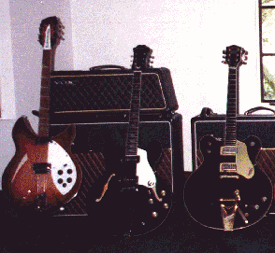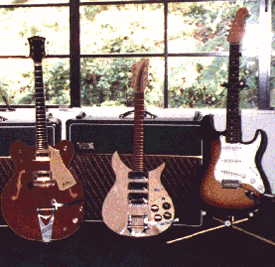Scroll through the lesson and click on notation/video/audio links to load the interactive players.
| Wolf Marshall >> British Blues Rock >> |
|
|
Please subscribe to get full access to all lessons for only $7.95/month PLUS 1 week free trial.

Riff Interactive lessons are
LESS expensive and
MORE interactive than alternatives!
More Info
|
|
Intro Wolf with Voxes

Wolf Marshall:
you'll be seeing some photos of British Invasion gear soon. These create THE
SOUND. I'd like to share something interesting with you all regarding the early British Blues Rock tone.
A lot of the guitarists used heavy flatwound strings. Like some jazz players.
Jed:
Can you explain what flatwound means?
Wolf Marshall:
flatwound strings are wound with metal tape and produce a very mellow tone.
Thanks so much for being here Hank.
ginny:
I noticed a VOX amp in the background Wolf, however, I thought I may see a
Rickenbacker this evening.
Wolf Marshall:
There will Rickys coming in the gear shots Gin
Beatles guitars 1

Beatles guitars 2

Wolf Marshall:
From the Wolf Marshall collection: British Invasion Extravaganza!
Front row L to R: Rickenbacker 360/12, Epiphone Casino, 1963 Gretsch
Country Gentleman, 1964 Gretsch Nashville, Rickenbacker 325,
1964 Fender Stratocaster.
Rack row L to R: 1965 Vox Buckingham amp top, and three Vox AC-30
combo amps. I used these to replicate the early Beatle tone
ginny:
What is it that gives a Ricky such a distinct tone? is there something different about them?
Wolf Marshall:
Gin. It has a hollow body and different scale. And pickups are voiced differently too.
The 12-string has reversed stringing.
ginny:
reversed strining these are new to me.
Wolf Marshall:
usually 12-strings have the high octave first. Opposite on Rick. It was an experiment.
The first one was normal.
gman:
wolf which amp and guitar did you use for the last lick?
Wolf Marshall:
It was a Gibson ES-175 and Vox AC-30. You all can tell the Chuck Berry influence on that.
This is a blues R&B lick in D. Double stops and pentatonic scale. It fits the classic shuffle D5-D6 groove
Dan:
what's a D5-D6 groove?
Wolf Marshall:
The progression of two power chords D5 and D6 in a pattern for comping. Can you all hear the flatwound sound and the AC-30 tone?
ginny:
the tone kind of plunks along, it doesn't ring or resonate as much, yes? I dunno.
Wolf Marshall:
Gin. it is typical of the early use of Berry type licks in British rock. The idea is to see where it all began And what started it.
Here's another lick
Wolf Marshall:
This one has the same tone. But it has some fingerpicked double stops. Sort of lick Buddy Guy blues licks.
Listen to the music . You can hear the actual Berry licks transplanted and of course Buddy Guy!
It's a mix of blues, rockabilly and originality. Remember...all the great early blues rock groups studied American records.
ginny:
but all the British Rockers were influenced by Blues artists.
Wolf Marshall:
Not all--Herman's Hermits?
dgguitar:
Which key is this licks?
Wolf Marshall:
DG, this is in C. DG, it uses a particular fingerpicking style. Pick+fingers, The pick and finger tech is also used by Albert lee
ginny:
Wolf, the ending (next to last measure) to that lick sounds .......different.
Wolf Marshall:
It has an unusual dissonance, which gives it personality
ginny:
thank you., I wasn't sure that dissonance was the right word to use, and now, I know.
Wolf Marshall:
Here comes a close look at the AC-30
Vox AC-30

Vox AC-30 controls

Wolf Marshall:
This is my VOX AC-30. VOX AC-30/6 Top Boost Amp 1963 model.
Controls. From left to right.
Inputs (high and low sensitivity) for three channels: 1) Vibrato-Tremolo, 2) Normal, 3) Brilliant. Speed control for Vibrato or Tremolo effect. Vibrato-Tremolo mode selector. Volume control for channels 1-3. Tone controls: Treble and Bass for Brilliant channel (Top Boost) and Cut for all three channels. Standby switch and pilot light. Power switch and pilot light.
This is the amp you're hearing on early Beatles, Stones, virtually every early British group used one. It is the SOUND.
Animals, Yardbirds... You can put Clapton, Beck, Jimmy Page, others in there
ginny:
Wolf Vox - it's been around a long time. do they still make them? and are they tube or have they gone solid state?
Wolf Marshall:
Gin, tubes. and they are reissued--quite authentic. The controls will tell you something. Compare them with a Fender combo of the same era.
There is a cut control which is quite active in tone shaping the bright channel among other things
also three channels--AND both vibrato and tremolo.
Dan:
what does "cut control" mean?
Wolf Marshall:
You have to hear it but basically...Cut works with the bright (Brilliant channel) to mix presence and mids after treble and bass are set up.
It was unique to Voxes. Here comes the next lick all, This one is an intro figure. British version of an American R&B classic.
Again it's a hollow body with AC-30. You all may hear something that almost sounds like wah on the first notes. It's just amp and guitar.
Wolf Marshall:
This is a real blues-based lick...follows the same prog as Texas Flood, another big big influence on early British rock was John Lee Hooker.
The Hooker influence was big with the Rolling Stones and Animals.
Wolf Marshall:
This boogie lick is like a mix of John Lee Hooker and Slim Harpo, Y'know, even those names are charasmatic!
Dan:
Who is Slim Harpo?
Wolf Marshall:
Slim Harpo was a blues player who wrote a bunch of great blues tunes like Shake Your Hips. Stones: Exile LP.
The boogie was picked up by so many rock players the list would be endless--from Stones to Van Halen and Satch.
Along with this lick is a closeup of boogie picking technique. Well, the time has come to say goodbye for the week. Please e-mail if you have any questions.
I want to thank Hank again for joining us, check the EMP "Lick of the Day" for related licks.
Next week we'll look at early Clapton, Beck and Page blues rock.
|
<< load notation from left
|
|
<< load audio from left
|
<< load audio from left
|